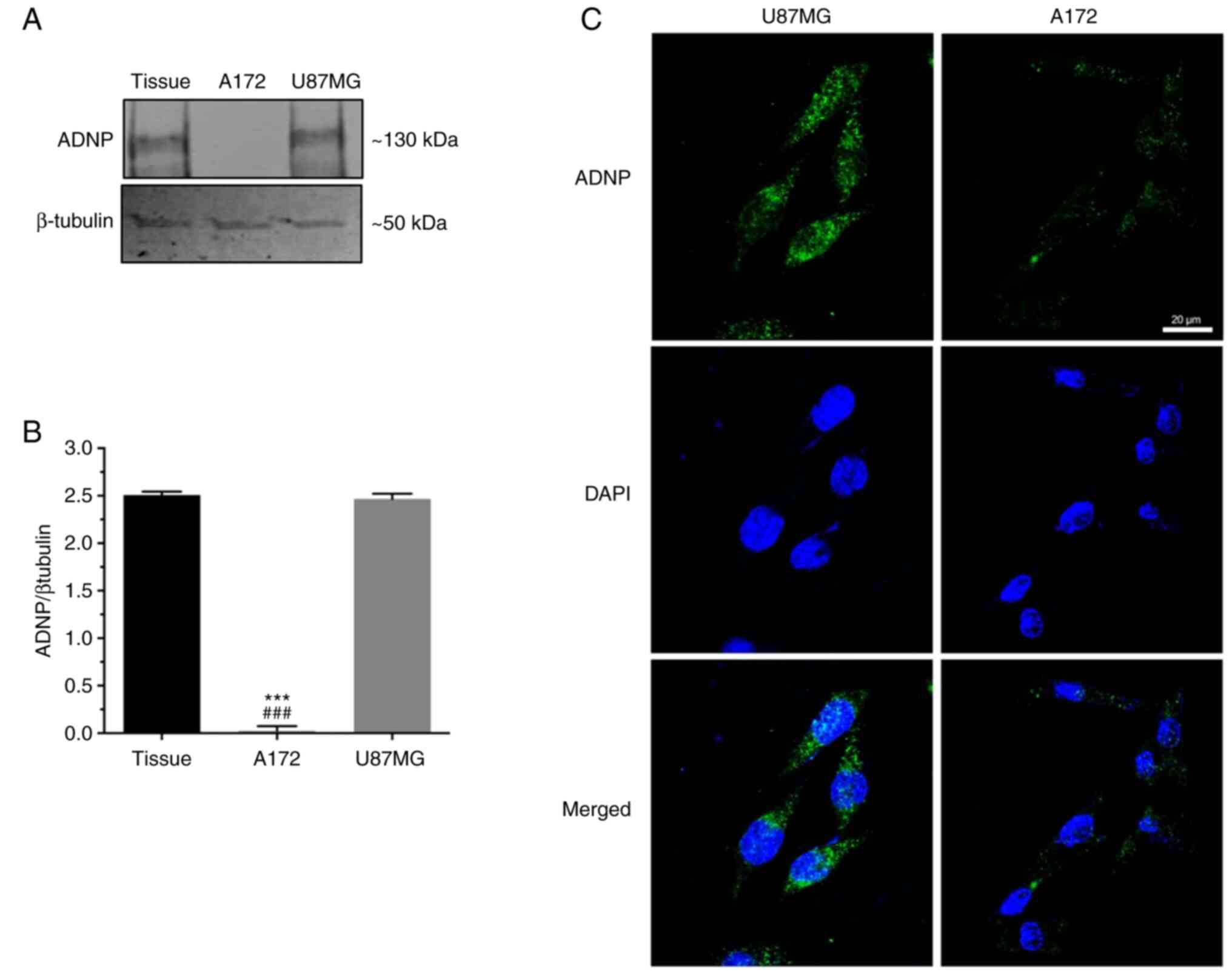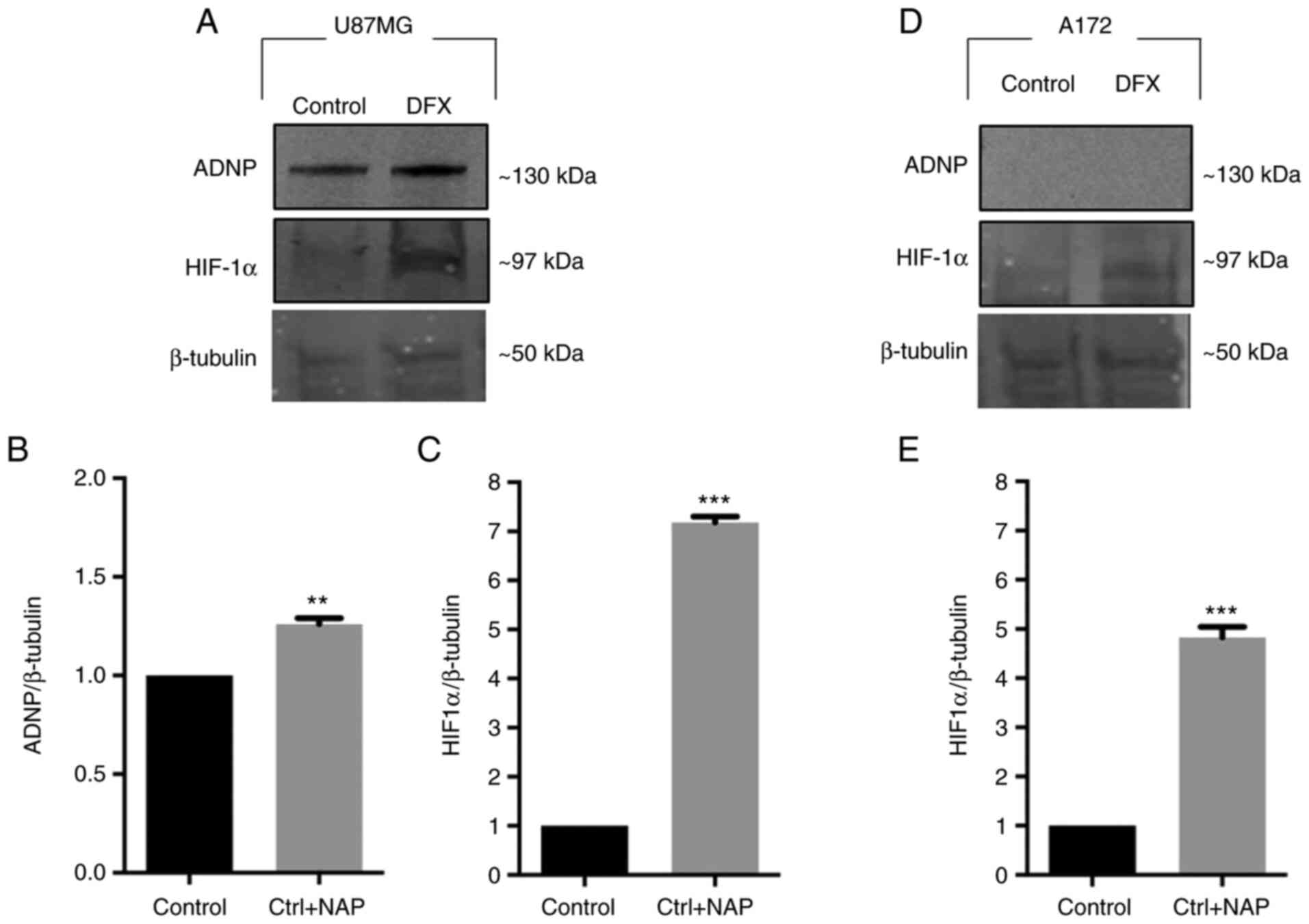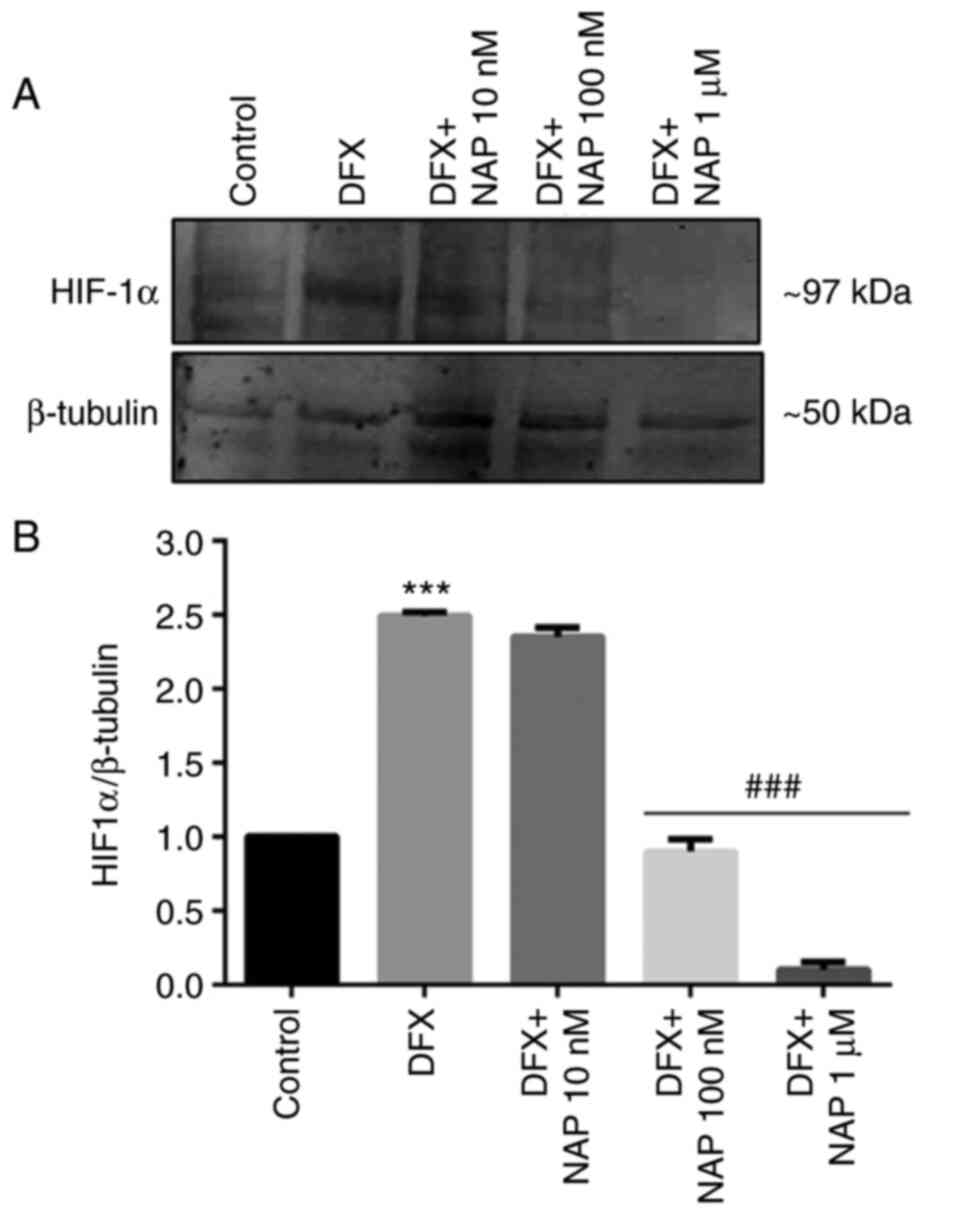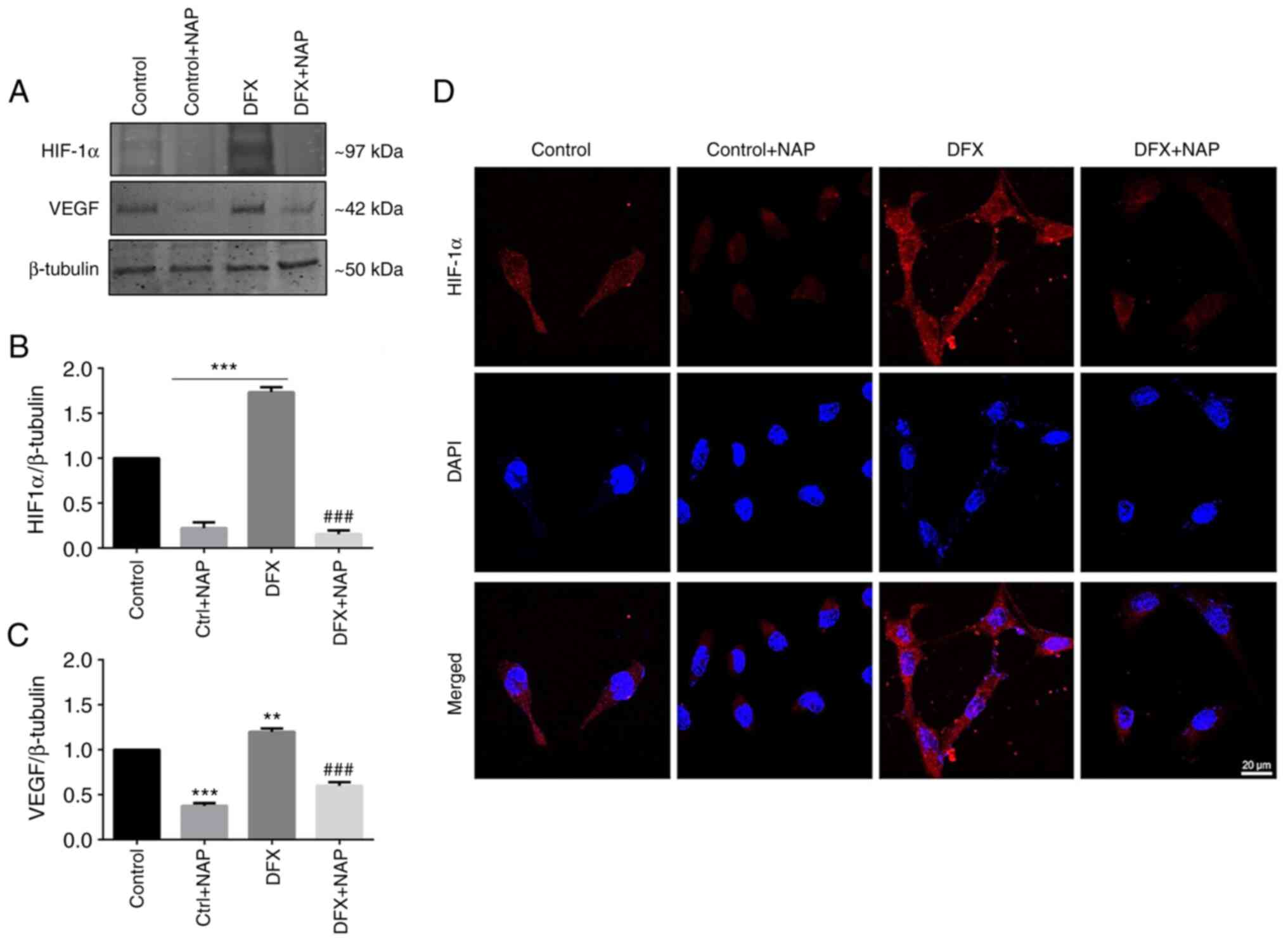|
1
|
Wesseling P and Capper D: WHO 2016
classification of gliomas. Neuropathol Appl Neurobiol. 44:139–150.
2018. View Article : Google Scholar : PubMed/NCBI
|
|
2
|
D'Amico AG, Maugeri G, Vanella L, Pittalà
V, Reglodi D and D'Agata V: Multimodal role of PACAP in
glioblastoma. Brain Sci. 11:9942021. View Article : Google Scholar : PubMed/NCBI
|
|
3
|
Wenger A, Vega SF, Kling T, Bontell TO,
Jakola AS and Carén H: Intratumor DNA methylation heterogeneity in
glioblastoma: Implications for DNA methylation-based
classification. Neuro Oncol. 21:616–627. 2019. View Article : Google Scholar : PubMed/NCBI
|
|
4
|
Semenza GL: Intratumoral hypoxia,
radiation resistance, and HIF-1. Cancer Cell. 5:405–406. 2004.
View Article : Google Scholar : PubMed/NCBI
|
|
5
|
Vaupel P and Mayer A: Hypoxia in cancer:
Significance and impact on clinical outcome. Cancer Metastasis Rev.
26:225–239. 2007. View Article : Google Scholar : PubMed/NCBI
|
|
6
|
Maugeri G, D'Amico AG, Reitano R, Magro G,
Cavallaro S, Salomone S and D'Agata V: PACAP and vip inhibit the
invasiveness of glioblastoma cells exposed to hypoxia through the
regulation of HIFs and EGFR expression. Front Pharmacol. 7:1392016.
View Article : Google Scholar : PubMed/NCBI
|
|
7
|
Maugeri G, D'Amico AG, Rasà DM, Saccone S,
Federico C, Cavallaro S and D'Agata V: PACAP and VIP regulate
hypoxia-inducible factors in neuroblastoma cells exposed to
hypoxia. Neuropeptides. 69:84–91. 2018. View Article : Google Scholar : PubMed/NCBI
|
|
8
|
Anjum K, Shagufta BI, Abbas SQ, Patel S,
Khan I, Shah SAA, Akhter N and Hassan SSU: Current status and
future therapeutic perspectives of glioblastoma multiforme (GBM)
therapy: A review. Biomed Pharmacother. 92:681–689. 2017.
View Article : Google Scholar : PubMed/NCBI
|
|
9
|
Touat M, Idbaih A, Sanson M and Ligon KL:
Glioblastoma targeted therapy: Updated approaches from recent
biological insights. Ann Oncol. 28:1457–1472. 2017. View Article : Google Scholar : PubMed/NCBI
|
|
10
|
Stupp R, Mason WP, van den Bent MJ, Weller
M, Fisher B, Taphoorn MJ, Belanger K, Brandes AA, Marosi C, Bogdahn
U, et al: Radiotherapy plus concomitant and adjuvant temozolomide
for glioblastoma. N Engl J Med. 352:987–996. 2005. View Article : Google Scholar : PubMed/NCBI
|
|
11
|
Weller M, van den Bent M, Tonn JC, Stupp
R, Preusser M, Cohen-Jonathan-Moyal E, Henriksson R, Rhun EL,
Balana C, Chinot O, et al: European association for neuro-oncology
(EANO) guideline on the diagnosis and treatment of adult astrocytic
and oligodendroglial gliomas. Lancet Oncol. 8:e315–e329. 2017.
View Article : Google Scholar : PubMed/NCBI
|
|
12
|
Cochaud S, Chevrier L, Meunier AC, Brillet
T, Chadéneau C and Muller JM: The vasoactive intestinal
peptide-receptor system is involved in human glioblastoma cell
migration. Neuropeptides. 44:373–383. 2010. View Article : Google Scholar : PubMed/NCBI
|
|
13
|
Cochaud S, Meunier AC, Monvoisin A,
Bensalma S, Muller JM and Chadéneau C: Neuropeptides of the VIP
family inhibit glioblastoma cell invasion. J Neurooncol. 122:63–73.
2015. View Article : Google Scholar : PubMed/NCBI
|
|
14
|
Maugeri G, D'Amico AG, Saccone S, Federico
C, Rasà DM, Caltabiano R, Broggi G, Giunta S, Musumeci G and
D'Agata V: Effect of PACAP on hypoxia-induced angiogenesis and
epithelial-mesenchymal transition in glioblastoma. Biomedicines.
9:9652021. View Article : Google Scholar : PubMed/NCBI
|
|
15
|
Toth D, Szabo E, Tamas A, Juhasz T,
Horvath G, Fabian E, Opper B, Szabo D, Maugeri G, D'Amico AG, et
al: Protective effects of PACAP in peripheral organs. Front
Endocrinol (Lausanne). 11:3772020. View Article : Google Scholar : PubMed/NCBI
|
|
16
|
D'Amico AG, Maugeri G, Saccone S, Federico
C, Cavallaro S, Reglodi D and D'Agata V: PACAP modulates the
autophagy process in an in vitro model of amyotrophic lateral
sclerosis. Int J Mol Sci. 21:29432020. View Article : Google Scholar : PubMed/NCBI
|
|
17
|
Lauretta G, Ravalli S, Szychlinska MA,
Castorina A, Maugeri G, D'Amico AG, D'Agata V and Musumeci G:
Current knowledge of pituitary adenylate cyclase activating
polypeptide (PACAP) in articular cartilage. Histol Histopathol.
35:1251–1262. 2020.PubMed/NCBI
|
|
18
|
D'Amico AG, Maugeri G, Musumeci G, Reglodi
D and D'Agata V: PACAP and NAP: Effect of two functionally related
peptides in diabetic retinopathy. J Mol Neurosci. 71:1525–1535.
2021. View Article : Google Scholar : PubMed/NCBI
|
|
19
|
Maugeri G, D'Amico AG, Musumeci G, Reglodi
D and D'Agata V: Effects of pacap on schwann cells: Focus on nerve
injury. Int J Mol Sci. 21:82332020. View Article : Google Scholar : PubMed/NCBI
|
|
20
|
Castorina A, Scuderi S, D'Amico AG, Drago
F and D'Agata V: PACAP and VIP increase the expression of
myelin-related proteins in rat schwannoma cells: Involvement of
PAC1/VPAC2 receptor-mediated activation of PI3K/Akt signaling
pathways. Exp Cell Res. 322:108–121. 2014. View Article : Google Scholar : PubMed/NCBI
|
|
21
|
Maugeri G, D'Amico AG, Bucolo C and
D'Agata V: Protective effect of PACAP-38 on retinal pigmented
epithelium in an in vitro and in vivo model of diabetic retinopathy
through EGFR-dependent mechanism. Peptides. 119:1701082019.
View Article : Google Scholar : PubMed/NCBI
|
|
22
|
Vaudry D, Falluel-Morel A, Bourgault S,
Basille M, Burel D, Wurtz O, Fournier A, Chow BK, Hashimoto H,
Galas L and Vaudry H: Pituitary adenylate cyclase-activating
polypeptide and its receptors: 20 years after the discovery.
Pharmacol Rev. 61:283–357. 2009. View Article : Google Scholar : PubMed/NCBI
|
|
23
|
Zusev M and Gozes I: Differential
regulation of activity-dependent neuroprotective protein in rat
astrocytes by VIP and PACAP. Regul Pept. 123:33–41. 2004.
View Article : Google Scholar : PubMed/NCBI
|
|
24
|
Dejda A, Sokołowska P and Nowak JZ:
Neuroprotective potential of three neuropeptides PACAP, VIP and
PHI. Pharmacol Rep. 57:307–320. 2005.PubMed/NCBI
|
|
25
|
Lelievre V, Ghiani CA, Seksenyan A,
Gressens P, de Vellis J and Waschek JA: Growth factor-dependent
actions of PACAP on oligodendrocyte progenitor proliferation. Regul
Pept. 137:58–66. 2006. View Article : Google Scholar : PubMed/NCBI
|
|
26
|
Bassan M, Zamostiano R, Davidson A,
Pinhasov A, Giladi E, Perl O, Bassan H, Blat C, Gibney G, Glazner
G, et al: Complete sequence of a novel protein containing a
femtomolar-activity-dependent neuroprotective peptide. J Neurochem.
72:1283–1293. 1999. View Article : Google Scholar : PubMed/NCBI
|
|
27
|
Gozes I, Bassan M, Zamostiano R, Pinhasov
A, Davidson A, Giladi E, Perl O, Glazner GW and Brenneman DE: A
novel signaling molecule for neuropeptide action:
Activity-dependent neuroprotective protein. Ann N Y Acad Sci.
897:125–135. 1999. View Article : Google Scholar : PubMed/NCBI
|
|
28
|
Zamostiano R, Pinhasov A, Gelber E,
Steingart RA, Seroussi E, Giladi E, Bassan M, Wollman Y, Eyre HJ,
Mulley JC, et al: Cloning and characterization of the human
activity-dependent neuroprotective protein. J Biol Chem.
276:708–714. 2001. View Article : Google Scholar : PubMed/NCBI
|
|
29
|
Li M, David C, Kikuta T, Somogyvari-Vigh A
and Arimura A: Signaling cascades involved in neuroprotection by
subpicomolar pituitary adenylate cyclase-activating polypeptide 38.
J Mol Neurosci. 27:91–105. 2005. View Article : Google Scholar : PubMed/NCBI
|
|
30
|
Nakamachi T, Li M, Shioda S and Arimura A:
Signaling involved in pituitary adenylate cyclase-activating
polypeptide-stimulated ADNP expression. Peptides. 27:1859–1864.
2006. View Article : Google Scholar : PubMed/NCBI
|
|
31
|
Nakamachi T, Ohtaki H, Yofu S, Dohi K,
Watanabe J, Hayashi D, Matsuno R, Nonaka N, Itabashi K and Shioda
S: Pituitary adenylate cyclase-activating polypeptide (PACAP) type
1 receptor (PAC1R) co-localizes with activity-dependent
neuroprotective protein (ADNP) in the mouse brains. Regul Pept.
145:88–95. 2008. View Article : Google Scholar : PubMed/NCBI
|
|
32
|
Gozes I, Alcalay R, Giladi E, Pinhasov A,
Furman S and Brenneman DE: NAP accelerates the performance of
normal rats in the water maze. J Mol Neurosci. 19:167–170. 2002.
View Article : Google Scholar : PubMed/NCBI
|
|
33
|
Pinhasov A, Mandel S, Torchinsky A, Giladi
E, Pittel Z, Goldsweig AM, Servoss SJ, Brenneman DE and Gozes I:
Activity-dependent neuroprotective protein: A novel gene essential
for brain formation. Brain Res Dev Brain Res. 144:83–90. 2003.
View Article : Google Scholar : PubMed/NCBI
|
|
34
|
Castorina A, Giunta S, Scuderi S and
D'Agata V: Involvement of PACAP/ADNP signaling in the resistance to
cell death in malignant peripheral nerve sheath tumor (MPNST)
cells. J Mol Neurosci. 48:674–683. 2012. View Article : Google Scholar : PubMed/NCBI
|
|
35
|
Blaj C, Bringmann A, Schmidt EM, Urbischek
M, Lamprecht S, Fröhlich T, Arnold GJ, Krebs S, Blum H, Hermeking
H, et al: ADNP is a therapeutically inducible repressor of WNT
signaling in colorectal cancer. Clin Cancer Res. 23:2769–2780.
2017. View Article : Google Scholar : PubMed/NCBI
|
|
36
|
Rangel R, Guzman-Rojas L, Kodama T, Kodama
M, Newberg JY, Copeland NG and Jenkins NA: Identification of new
tumor suppressor genes in triple-negative breast cancer. Cancer
Res. 77:4089–4101. 2017. View Article : Google Scholar : PubMed/NCBI
|
|
37
|
Karagoz K, Mehta GA, Khella CA, Khanna P
and Gatza ML: Integrative proteogenomic analyses of human tumours
identifies ADNP as a novel oncogenic mediator of cell cycle
progression in high-grade serous ovarian cancer with poor
prognosis. EBioMedicine. 50:191–202. 2019. View Article : Google Scholar : PubMed/NCBI
|
|
38
|
Zhu S, Xu Z, Zeng Y, Long Y, Fan G, Ding
Q, Wen Y, Cao J, Dai T, Han W and Xie Y: ADNP upregulation promotes
bladder cancer cell proliferation via the AKT Pathway. Front Oncol.
10:4911292020. View Article : Google Scholar : PubMed/NCBI
|
|
39
|
Turashvili G: ADNP (Activity Dependent
Neuroprotector Homeobox): A novel oncogene driving poor prognosis
in high-grade serous carcinoma. EBioMedicine. 51:1025892020.
View Article : Google Scholar : PubMed/NCBI
|
|
40
|
Gozes I, Morimoto BH, Tiong J, Fox A,
Sutherland K, Dangoor D, Holser-Cochav M, Vered K, Newton P, Aisen
PS, et al: NAP: Research and development of a peptide derived from
activity-dependent neuroprotective protein (ADNP). CNS Drug Rev.
11:353–368. 2005. View Article : Google Scholar : PubMed/NCBI
|
|
41
|
Gozes I: Activity-dependent
neuroprotective protein: From gene to drug candidate. Pharmacol
Ther. 114:146–154. 2007. View Article : Google Scholar : PubMed/NCBI
|
|
42
|
Gozes I: NAP (davunetide) provides
functional and structural neuroprotection. Curr Pharm Des.
17:1040–1044. 2011. View Article : Google Scholar : PubMed/NCBI
|
|
43
|
Maugeri G, D'Amico AG, Rasà DM, Saccone S,
Federico C, Magro G, Cavallaro S and D'Agata V: Caffeine effect on
HIFs/VEGF pathway in human glioblastoma cells exposed to hypoxia.
Anticancer Agents Med Chem. 18:1432–1439. 2018. View Article : Google Scholar : PubMed/NCBI
|
|
44
|
Bonaventura G, Iemmolo R, D'Amico AG, La
Cognata V, Costanzo E, Zappia M, D'Agata V, Conforti FL, Aronica E
and Cavallaro S: PACAP and PAC1R are differentially expressed in
motor cortex of amyotrophic lateral sclerosis patients and support
survival of iPSC-derived motor neurons. J Cell Physiol.
233:3343–3351. 2018. View Article : Google Scholar : PubMed/NCBI
|
|
45
|
D'Agata V, Grimaldi M, Pascale A and
Cavallaro S: Regional and cellular expression of the parkin gene in
the rat cerebral cortex. Eur J Neurosci. 12:3583–3588. 2000.
View Article : Google Scholar : PubMed/NCBI
|
|
46
|
Yao M, Li S, Wu X, Diao S, Zhang G, He H,
Bian L and Lu Y: Cellular origin of glioblastoma and its
implication in precision therapy. Cell Mol Immunol. 15:737–739.
2018. View Article : Google Scholar : PubMed/NCBI
|
|
47
|
Guichet PO, Guelfi S, Ripoll C, Teigell M,
Sabourin JC, Bauchet L, Rigau V, Rothhut B and Hugnot JP:
Asymmetric distribution of GFAP in glioma multipotent cells. PLoS
One. 11:e01512742016. View Article : Google Scholar : PubMed/NCBI
|
|
48
|
Kim HJ, Park JW and Lee JH: Genetic
architectures and cell-of-origin in glioblastoma. Front Oncol.
10:6154002020. View Article : Google Scholar : PubMed/NCBI
|
|
49
|
Belot N, Rorive S, Doyen I, Lefranc F,
Bruyneel E, Dedecker R, Micik S, Brotchi J, Decaestecker C, Salmon
I, et al: Molecular characterization of cell substratum attachments
in human glial tumors relates to prognostic features. Glia.
36:375–390. 2001. View Article : Google Scholar : PubMed/NCBI
|
|
50
|
Bensalma S, Turpault S, Balandre AC, De
Boisvilliers M, Gaillard A, Chadéneau C and Muller JM: PKA at a
cross-road of signaling pathways involved in the regulation of
glioblastoma migration and invasion by the neuropeptides VIP and
PACAP. Cancers (Basel). 11:1232019. View Article : Google Scholar : PubMed/NCBI
|
|
51
|
D'Amico AG, Scuderi S, Saccone S,
Castorina A, Drago F and D'Agata V: Antiproliferative effects of
PACAP and VIP in serum-starved glioma cells. J Mol Neurosci.
51:503–513. 2013. View Article : Google Scholar : PubMed/NCBI
|
|
52
|
Gozes I and Ivashko-Pachima Y: ADNP: In
search for molecular mechanisms and innovative therapeutic
strategies for frontotemporal degeneration. Front Aging Neurosci.
7:2052015. View Article : Google Scholar : PubMed/NCBI
|
|
53
|
Gozes I, Yeheskel A and Pasmanik-Chor M:
Activity-dependent neuroprotective protein (ADNP): A case study for
highly conserved chordata-specific genes shaping the brain and
mutated in cancer. J Alzheimers Dis. 45:57–73. 2015. View Article : Google Scholar : PubMed/NCBI
|
|
54
|
Jo YS, Kim MS, Yoo NJ, Lee SH and Song SY:
ADNP encoding a transcription factor interacting with BAF complexes
exhibits frameshift mutations in gastric and colorectal cancers.
Scand J Gastroenterol. 51:1269–1271. 2016. View Article : Google Scholar : PubMed/NCBI
|
|
55
|
Xie Y, Zhu S, Zang J, Wu G, Wen Y, Liang
Y, Long Y, Guo W, Zang C, Hu X, et al: ADNP prompts the
cisplatin-resistance of bladder cancer via TGF-β-mediated
epithelial-mesenchymal transition (EMT) pathway. J Cancer.
12:5114–5124. 2021. View Article : Google Scholar : PubMed/NCBI
|
|
56
|
Scuderi S, D'Amico AG, Castorina A,
Federico C, Marrazzo G, Drago F, Bucolo C and D'Agata V: Davunetide
(NAP) protects the retina against early diabetic injury by reducing
apoptotic death. J Mol Neurosci. 54:395–404. 2014. View Article : Google Scholar : PubMed/NCBI
|
|
57
|
D'Amico AG, Scuderi S, Maugeri G,
Cavallaro S, Drago F and D'Agata V: NAP reduces murine
microvascular endothelial cells proliferation induced by
hyperglycemia. J Mol Neurosci. 54:405–413. 2014. View Article : Google Scholar : PubMed/NCBI
|
|
58
|
Bergers G and Benjamin LE: Tumorigenesis
and the angiogenic switch. Nat Rev Cancer. 3:401–410. 2003.
View Article : Google Scholar : PubMed/NCBI
|





















